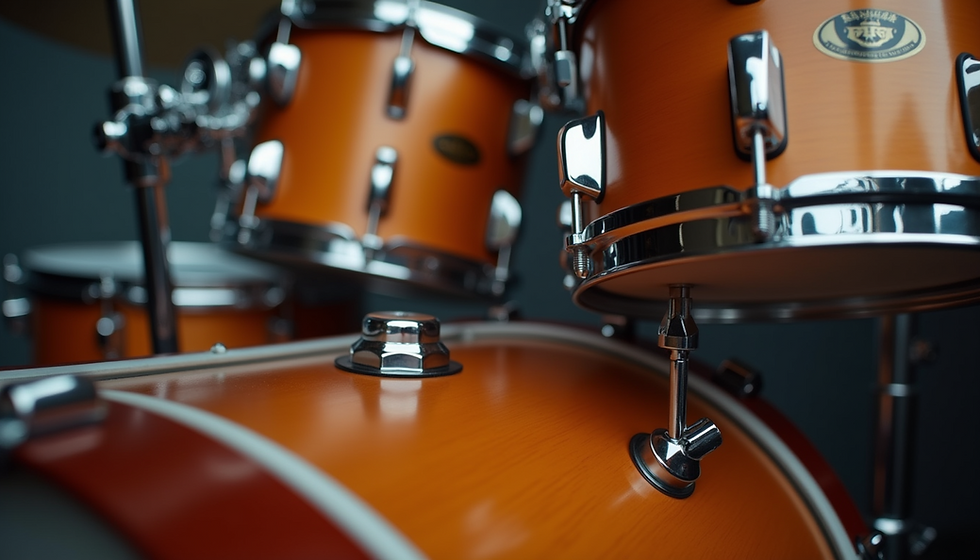8 practical tips for building an essential music portfolio for drummers
- Maisie Loh
- 48 minutes ago
- 3 min read
Crafting a music portfolio as a drummer is a crucial step in presenting your skills, experiences, and unique style. Regardless of whether you're trying to land gigs, collaborate with musicians, or track your progress, a polished portfolio can greatly enhance your chances of success. In this post, we will explore eight practical tips to help you build an impressive music portfolio that stands out.
Define Your Goals
Before you start building your portfolio, it's essential to clarify your goals. Are you looking to attract new opportunities, showcase your versatility, or document your growth as a musician? Understanding your objectives will shape the content and structure of your portfolio.
For example, if you want to secure live performance opportunities, emphasize recordings of your performances along with positive testimonials from fellow musicians. A focused approach can enable you to create a compelling narrative that resonates with your audience.
Choose the Right Format
There are several formats for your music portfolio, including a physical booklet, a digital website, or a social media profile. Each format has its strengths, so think about your target audience and how they prefer to engage with your work.
A digital portfolio is often more accessible. Websites can host your videos, audio clips, and texts, while social media platforms can help you connect with a larger audience. If you decide to create a website, ensure it features user-friendly navigation and fresh content to keep visitors engaged. For example, using platforms like Bandcamp or SoundCloud can allow you to easily update and share your latest tracks.
Curate Your Best Work
When building your portfolio, prioritize quality over quantity. Select standout performances, recordings, and compositions that effectively showcase your skills and versatility as a drummer. Aim for diversity to demonstrate your adaptability across different styles and genres.
Include a variety of work, such as live recordings from local gigs, studio sessions with different artists, and original compositions you’ve created. This mosaic will provide potential collaborators and employers with a well-rounded view of your capabilities. For instance, if you have played in rock, jazz, and electronic music settings, include clips that capture those various sounds.

Include a Bio
A concise and engaging bio is a vital part of your music portfolio. It should narrate your musical journey, highlight your influences, and showcase your achievements. Keep it to around 200–300 words to maintain the reader's interest.
Make sure your bio reflects your personality and musical style. For example, if you played with renowned bands or won any awards, mention those highlights. These details can enhance your credibility as a drummer and give readers insight into who you are as an artist.
Showcase Your Skills
In addition to recordings and a bio, consider adding a section that outlines your specific skills. This could include techniques you excel in, such as playing in odd time signatures, improvisation, or proficiency with multiple percussion instruments.
Including endorsements or testimonials from fellow musicians can also add weight to your portfolio. A quote from a respected music instructor or a band leader that emphasizes your dedication and talent can significantly boost your credibility, showing potential collaborators that you can deliver on your promises.
Keep It Updated
Your music portfolio should be a living document that grows alongside your journey as a musician. Make it a habit to regularly update your portfolio with new recordings, performances, and notable achievements. This not only keeps your content fresh but also mirrors your ongoing development.
Set a schedule for these updates, whether it's every three months or twice a year. This routine will ensure your portfolio always reflects your current skills and experiences, maximizing your chances of impressing potential collaborators or employers.

Network and Collaborate
Building your music portfolio extends beyond showcasing your work; it also involves forging connections with other musicians. Networking can open doors to collaborations and gigs that enrich your portfolio.
Attend local music events, engage in online forums, and participate in workshops to meet other artists. Collaborating can result in fresh content for your portfolio. For instance, if you team up with a singer-songwriter for a recording, include that material to demonstrate your versatility and ability to work in a team setting.
Seek Feedback
After assembling your portfolio, it's wise to seek feedback from trusted peers or mentors in the music industry. This constructive criticism can help pinpoint areas for improvement and ensure that your presentation effectively communicates your skills and personality.
Share your portfolio with fellow drummers, your drum instructors, or even potential employers. Their insights can be invaluable in refining both your content and presentation.
Don't forget the importance of networking, collaboration, and feedback in improving your portfolio. With passion and creativity, your music portfolio can open doors to new opportunities and help you connect with fellow musicians and audiences alike. Start building your portfolio today and let your drumming journey shine!







Comments